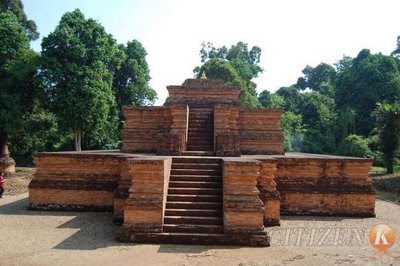Archaeologist Tim Hall Banjarmasin Archaeology began to reveal the brick pile in the Village of New District, Sub Benua Kayong, Ketapang, West Kalimantan. They concluded the old building as a temple after finding the sinks in the middle.
The existence of a pitting a requirement that an ancient building can be called a temple. Lead researcher Associate, Bambang Sakti Wiku Atmojo, Tuesday (12/10/2010), said, the main elements of a temple is the artifact, sinks, and reliefs.
If one of the main element is found, then the building is confirmed as a temple. However, to determine the temple is derived from any civilization, it still requires other historical objects.
"It's history that could be a clue is the inscription. Until now, we have not found it," said Bambang, found at the excavation site.
The inscriptions will be found, from what kingdom era buildings are erected. Pitting is the place peripih placed. Peripih is a kind of tray or rectangular-shaped tray which consists of nine boxes.
Each box contains several types of objects, such as rice seeds as well as silver or bronze metal. Its contents can also be a currency that can explain the building comes from how many centuries.
"The boxes can also contain writings of spells. Peripih usually used to offer it to god. On top of the wells are properly dry, not like now, there is water," he explained.
Usually, it's located on top peripih god statue made of andesite stone. However, these objects are not found again on the sinks.
Based on the conclusion while the strong suspicion that this temple came from the 14th century and the 15. The shape resembles a temple of the royal era in East Java, which is likely in the days of Hindu.
The main temple ascertained measuring 5.4 x 5.4 meters with a brick size 32-36 inches long. 4-6 inches brick thickness, and width of 13-17 centimeters. This temple is only using two main bricks on the edges.
There are 3 triangular viewer on the front. There is also found in two companion temple, or ancillary, located on the right facing the temple. According to him, there should be two accompanying temple again on the left side. However, it was not found.



















































